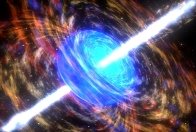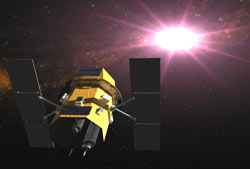Gamma Ray Bursts

Recent developments
in the study of
Gamma-ray bursts
The Royal Society
6-9 Carlton House Terrace
London SW1Y 5AG
Discussion Meeting: Monday 18 to Wednesday 20 September 2006
Professor Martin Rees PRS, Professor Len Culhane FRS, Professor Keith Mason and Professor Alan Wells
New results from the SWIFT mission and new theoretical studies of gamma ray burst physics are defining the agenda for this meeting.
SWIFT has detected over 140 bursts since its launch in November 2004. It has obtained the first accurate localizations and afterglow detections of short bursts, leading to the discovery that the progenitors are indeed mergers in compact binary systems.
For list of events see here
_______________________________________________________

A Flash in
the Cosmic Pan
18 Sept 2006
Image to left:
Dying stars like
the one inside
this planetary nebula
are a possible source
for gamma-ray bursts.
Credit: NASA
Like galactic fireworks in the night, gamma-ray bursts briefly light up the stellar sky as only the most powerful explosions in the universe can. Yet as magnificent as gamma-ray bursts are, their fleeting nature makes them elusive and difficult to study.
Gamma-ray bursts are incredibly intense releases of gamma radiation. Found at the highest frequency end of the electromagnetic spectrum, gamma radiation is a particularly energetic form of light that can only be generated by the most powerful astronomical events. Scientists suspect that these sporadic explosions may signal the birth of black holes or the death of stars.
The first gamma-ray bursts were detected in 1967 by the U.S. military's Vela satellites. This fleet of satellites was originally designed to monitor nuclear weapons testing and could sense large releases of gamma radiation. While orbiting the Earth, a Vela satellite recorded a burst of concentrated gamma energy from deep space. For the first time, a gamma-ray burst was observed by humans.
Modern, space-based gamma-ray burst research began in earnest with the 1991 launch of the Compton Gamma Ray Observatory aboard Space Shuttle Atlantis. For nine years, the Compton Observatory searched the sky for gamma-ray activity. In those years in orbit, the observatory made a number of discoveries and mapped thousands of gamma-ray bursts.
In 1997, the Italian Space Agency placed the BeppoSAX satellite in orbit and it made a critical discovery by identifying the lingering X-ray "afterglow" produced by erupting gamma-ray bursts. This finding allowed astronomers to look at the bursts in a new light, and paved the way for the design of new spacecraft like Swift.
Today, the pursuit of gamma-ray bursts continues since the launch of the Swift spacecraft. Armed with a trio of telescopes and a network of supporting space-based and ground telescopes, astronomers have managed to set a sophisticated trap that is ready to catch gamma-ray bursts in the act as they light up the night.
NASA mission pages
NASA's John F. Kennedy Space Center
_______________________________________________________

NASA Satellite
2 year Study of
Black Hole Birth
and
Gamma Ray Bursts
18 Sept 2006
By the end of this day, somewhere in the visible universe a new black hole will have formed. Gamma-ray bursts (GRBs), the most distant and powerful explosions known, are likely the birth cries of these new black holes. NASA's Swift mission is dedicated to studying the gamma-ray burst/black hole connection.
The Swift spacecraft began its mission from Cape Canaveral Air Force Station in 2004, building on nearly 40 years of research and observations. It is fine-tuned to quickly locate these bursts and study them in several different wavelengths before they disappear forever.
Swift is a little satellite with a big appetite, and caps off a 30-year hunt to understand the nature of gamma-ray bursts, flashes of light that burn as brightly as a billion billion suns.
Gamma-ray bursts are fleeting events, lasting only a few milliseconds to a few minutes, never to appear in the same spot again. They occur from our vantage point about once a day. Some bursts appear to be from massive star explosions that form black holes.
Read more: NASA watchtheskies/SWIFT Media
_______________________________________________________
Related Links:
Gamma Ray Detection by Plato
Cosmicopia: An abundance of Cosmic rays from helios nasa gov
_______________________________________________________
_______________________________________________________
Famous Quotes
The art of simplicity is a puzzle of complexity. Doug Horton
_______________________________________________________
Labels: GRBs, Particle Physics, Theoretical Physics


<< Home